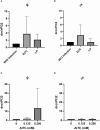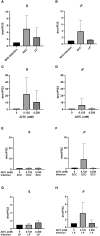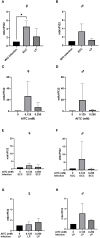Effect of allyl-isothiocyanate on survival and antimicrobial peptide expression following oral bacterial infections in Drosophila melanogaster
- PMID: 38803500
- PMCID: PMC11128604
- DOI: 10.3389/fimmu.2024.1404086
Effect of allyl-isothiocyanate on survival and antimicrobial peptide expression following oral bacterial infections in Drosophila melanogaster
Abstract
Since infections with antibiotic-resistant bacteria cause increasing problems worldwide, the identification of alternative therapies is of great importance. Plant-derived bioactives, including allyl-isothiocyanate (AITC), have received attention for their antimicrobial properties. The present study therefore investigates the impact of AITC on survival and antimicrobial peptide (AMP) levels in Drosophila melanogaster challenged with the fly pathogenic bacteria Pectobacterium carotovorum subsp. carotovorum and Leuconostoc pseudomesenteroides. AITC, a sulfur-containing compound derived from glucosinolates, exhibits antimicrobial properties and has been suggested to modulate AMP expression. By using D. melanogaster, we demonstrate that AITC treatment resulted in a concentration-dependent decrease of survival rates among female flies, particularly in the presence of the Gram-negative bacterium Pectobacterium carotovorum subsp. carotovorum, whereas AITC did not affect survival in male flies. Despite the ability of isothiocyanates to induce AMP expression in cell culture, we did not detect significant changes in AMP mRNA levels in infected flies exposed to AITC. Our findings suggest sex-specific differences in response to AITC treatment and bacterial infections, underlining the complexity of host-pathogen interactions and potential limitations of AITC as a preventive or therapeutic compound at least in D. melanogaster models of bacterial infections.
Keywords: Drosophila melanogaster; allyl-isothiocyanate; anti-microbial peptides; bioactive plant compound; gene expression; infection; survival.
Copyright © 2024 Zimmermann, Dähn and Wagner.
Conflict of interest statement
The authors declare that the research was conducted in the absence of any commercial or financial relationships that could be construed as a potential conflict of interest. The author(s) declared that they were an editorial board member of Frontiers, at the time of submission. This had no impact on the peer review process and the final decision.
Figures











Similar articles
-
Behavioral Aversion to AITC Requires Both Painless and dTRPA1 in Drosophila.Front Neural Circuits. 2018 Jul 3;12:45. doi: 10.3389/fncir.2018.00045. eCollection 2018. Front Neural Circuits. 2018. PMID: 30018539 Free PMC article.
-
Allyl isothiocyanate as a cancer chemopreventive phytochemical.Mol Nutr Food Res. 2010 Jan;54(1):127-35. doi: 10.1002/mnfr.200900323. Mol Nutr Food Res. 2010. PMID: 19960458 Free PMC article. Review.
-
Inhibition of Campylobacter jejuni on fresh chicken breasts by κ-carrageenan/chitosan-based coatings containing allyl isothiocyanate or deodorized oriental mustard extract.Int J Food Microbiol. 2014 Sep 18;187:77-82. doi: 10.1016/j.ijfoodmicro.2014.07.003. Epub 2014 Jul 11. Int J Food Microbiol. 2014. PMID: 25058687
-
Erwinia carotovora Quorum Sensing System Regulates Host-Specific Virulence Factors and Development Delay in Drosophila melanogaster.mBio. 2020 Jun 23;11(3):e01292-20. doi: 10.1128/mBio.01292-20. mBio. 2020. PMID: 32576677 Free PMC article.
-
Isothiocyanates: An Overview of Their Antimicrobial Activity against Human Infections.Molecules. 2018 Mar 9;23(3):624. doi: 10.3390/molecules23030624. Molecules. 2018. PMID: 29522501 Free PMC article. Review.
Cited by
-
Curcumin Induces Transgenerational and Sex-Specific Effects on Lifespan, Gene Expression, and Metabolism in the Fruit Fly Drosophila melanogaster.Biofactors. 2025 Jul-Aug;51(4):e70039. doi: 10.1002/biof.70039. Biofactors. 2025. PMID: 40751014 Free PMC article.
-
Drosophila melanogaster as a model organism to investigate sex specific differences.Sci Rep. 2025 Jun 4;15(1):19648. doi: 10.1038/s41598-025-04497-0. Sci Rep. 2025. PMID: 40467909 Free PMC article.
-
Odorant receptors mediating avoidance of toxic mustard oils in Drosophila melanogaster are expanded in herbivorous relatives.bioRxiv [Preprint]. 2025 May 29:2024.10.08.617316. doi: 10.1101/2024.10.08.617316. bioRxiv. 2025. Update in: Mol Biol Evol. 2025 Jul 04:msaf164. doi: 10.1093/molbev/msaf164. PMID: 39416046 Free PMC article. Updated. Preprint.
References
MeSH terms
Substances
LinkOut - more resources
Full Text Sources
Molecular Biology Databases

